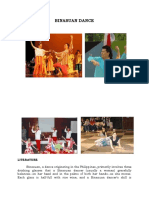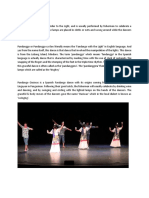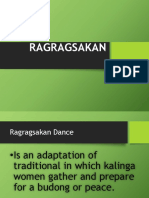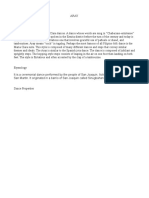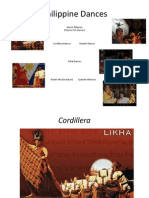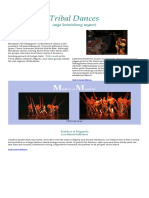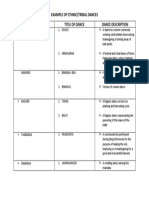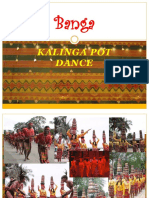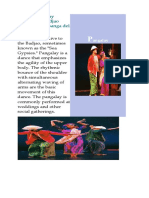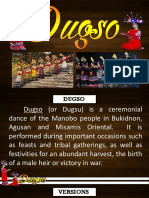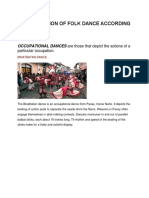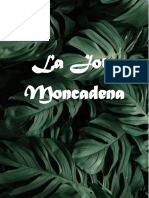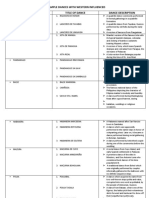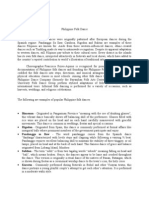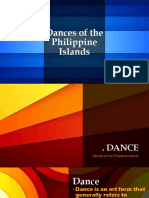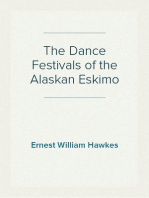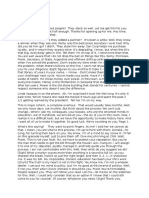100%(2)100% found this document useful (2 votes)
1K viewsTribal Dance
Tribal Dance
Uploaded by
TallieDreyTribal dances originated in Mindanao, Philippines and reflect the tribes' natural environments, rituals, and beliefs. Some examples of tribal dances from Mindanao include Malakas at Maganda of the Manobo tribe, which depicts folklore of the first man and woman emerging from a bamboo; Binaylan of the Bagobo tribe, which imitates interactions between a hen, chicks and hawk; and Kadal Tahaw of the T'boli tribe from South Cotabato, which mimics the movements of the Tahaw bird to celebrate good harvests.
Copyright:
© All Rights Reserved
Available Formats
Download as PPTX, PDF, TXT or read online from Scribd
Tribal Dance
Tribal Dance
Uploaded by
TallieDrey100%(2)100% found this document useful (2 votes)
1K views14 pagesTribal dances originated in Mindanao, Philippines and reflect the tribes' natural environments, rituals, and beliefs. Some examples of tribal dances from Mindanao include Malakas at Maganda of the Manobo tribe, which depicts folklore of the first man and woman emerging from a bamboo; Binaylan of the Bagobo tribe, which imitates interactions between a hen, chicks and hawk; and Kadal Tahaw of the T'boli tribe from South Cotabato, which mimics the movements of the Tahaw bird to celebrate good harvests.
Original Description:
Folk Dances in The Philippines
Original Title
Tribal-Dance
Copyright
© © All Rights Reserved
Available Formats
PPTX, PDF, TXT or read online from Scribd
Share this document
Did you find this document useful?
Is this content inappropriate?
Tribal dances originated in Mindanao, Philippines and reflect the tribes' natural environments, rituals, and beliefs. Some examples of tribal dances from Mindanao include Malakas at Maganda of the Manobo tribe, which depicts folklore of the first man and woman emerging from a bamboo; Binaylan of the Bagobo tribe, which imitates interactions between a hen, chicks and hawk; and Kadal Tahaw of the T'boli tribe from South Cotabato, which mimics the movements of the Tahaw bird to celebrate good harvests.
Copyright:
© All Rights Reserved
Available Formats
Download as PPTX, PDF, TXT or read online from Scribd
Download as pptx, pdf, or txt
100%(2)100% found this document useful (2 votes)
1K views14 pagesTribal Dance
Tribal Dance
Uploaded by
TallieDreyTribal dances originated in Mindanao, Philippines and reflect the tribes' natural environments, rituals, and beliefs. Some examples of tribal dances from Mindanao include Malakas at Maganda of the Manobo tribe, which depicts folklore of the first man and woman emerging from a bamboo; Binaylan of the Bagobo tribe, which imitates interactions between a hen, chicks and hawk; and Kadal Tahaw of the T'boli tribe from South Cotabato, which mimics the movements of the Tahaw bird to celebrate good harvests.
Copyright:
© All Rights Reserved
Available Formats
Download as PPTX, PDF, TXT or read online from Scribd
Download as pptx, pdf, or txt
You are on page 1of 14
Tribal DanceS
What is Tribal Dance?
• Tribal dances, also known as ethnic dances,
originated in Mindanao and are the type of
dances that reflect Mindanao's natural
environment as well as their rituals and beliefs.
Each dance form is unique in step and design
as it is related to the lifestyle of the people
from differing tribes.
• Tribes in Mindanao are known for their
intricate craftmanship in metal, clothing, and
jewelry which they commonly use as costumes
for their tribal dances.
Examples of Tribal Dances:
1. Malakas at Maganda
2. Binaylan
3. Bagobo Rice Cycle
4. Bugso
5. Kadal Tahaw
Malakas at Maganda
• Malakas at Maganda is a tribal dance. It interprets the
Manobo folklore wherein a weary bird perched on a large
bamboo heard strange noises inside. It pecked the
bamboo until it split open. From inside the bamboo came
the first man and woman Malakas (the strong) and
Maganda (the beautiful), respectively.
Malakas at maganda
Binaylan
• The Bagobo tribe from the central uplands of
Mindanao originated this dance which imitates the
movement of a hen, her banog, or baby chicks, and a
hawk. The hawk is sacred, and it is believed that the
hawk has the power over the well-being of the tribe.
The hawk tries to capture one of the chicks and is
killed by the hunters.
Binaylan
Bagobo Rice cycle
• This Bagobo tribal dance protrays the cycle of
planting and harvesting of rice.
• Originated from the Bagobo Tribe.
Bagobo rice cycle
Dugso
• Dugso (meaning 'dance') is a ceremonial dance among the Manobo
people in Bukidnon, Agusan and Misamis Oriental . The Dugso (also Dugsu)
is usually performed during important occasions like kaliga (feasts) or
kaamulan (tribal gatherings). Other occasions that call for the performance
of Dugso are festivities connected to abundant harvest, the birth of a male
heir or victory in war. Brandeis however, claimed that the dugso has no
specific occasion underpinning aside from that of the kaliga-on festivities.
He said that it is only performed to "entertain their deities". The Dugso for
a kaliga is usually performed on the third day which is usually the merriest
being the culmination of the whole celebrations.
•Dugso have at least twelve known versions and the most popular versions
are the Dugso Songco, Dugso Kalasungay, Dugso Cabanglasan, Lagoras,
Inaksyon and the Hinaklaran.
Dugso
Kadal tahaw
• Originating from South Cotabato, this tribal dance is
performed by T'boli tribe. It mimics the hopping and
flying behavior of the Tahaw Bird. Malong and salakut
(hat) is worn in this dance. This is performed to celebrate
good harvest.
Kadal tahaw
Thank you for
listening
You might also like
- Example of Muslim Dances Group Title of Dance Dance DescriptionDocument1 pageExample of Muslim Dances Group Title of Dance Dance DescriptionYhazmin Iris Ilustrisimo50% (2)
- Binasuan Dance: LiteratureDocument16 pagesBinasuan Dance: Literatureehrojrham14350% (4)
- Folk DancesDocument9 pagesFolk DancesMr 73ieNo ratings yet
- Pandanggo Oasiw-WPS OfficeDocument2 pagesPandanggo Oasiw-WPS OfficeAlmira sibulNo ratings yet
- Folk DancesDocument12 pagesFolk DancesCarmela Kristine JordaNo ratings yet
- Cordillera DanceDocument7 pagesCordillera DanceRica Ponce Consignado0% (1)
- RagragsakanDocument6 pagesRagragsakanRazel Hijastro86% (7)
- ARAYDocument1 pageARAYJaden Moniez100% (2)
- Sanctus Germanus Prophecies, Volume 3Document221 pagesSanctus Germanus Prophecies, Volume 3Monique Neal100% (1)
- A Commentary On The Star SapphireDocument15 pagesA Commentary On The Star SapphiretorstNo ratings yet
- Welcome: To Effective Christian Leadership For EvangelismDocument69 pagesWelcome: To Effective Christian Leadership For Evangelismrbenhur100% (2)
- IncantationDocument31 pagesIncantationIregbemi93% (124)
- Philippine Dances: Sayaw PilipinasDocument40 pagesPhilippine Dances: Sayaw PilipinasMariz Hernando50% (2)
- Tribal DancesDocument3 pagesTribal DancesGianne Azel Gorne Torrejos-SaludoNo ratings yet
- Pagdiwata Festival: Date: December 8 Location: Puerto Princesa, PalawanDocument2 pagesPagdiwata Festival: Date: December 8 Location: Puerto Princesa, PalawanJamaica Millanes Rosell100% (1)
- Ethnic and Tribal Dance Group-1Document1 pageEthnic and Tribal Dance Group-1Yhazmin Iris IlustrisimoNo ratings yet
- Maria Clara SuiteDocument20 pagesMaria Clara SuiteRommel Villaroman EstevesNo ratings yet
- Module 1: Nature and Elements of Dance: ChoreographyDocument6 pagesModule 1: Nature and Elements of Dance: Choreographyrom keroNo ratings yet
- Tinikling ReportDocument31 pagesTinikling ReportKYCIE FIDELICIO100% (1)
- Cordillera: Classifications of Dances Found in The Philippines (Dances of The Cordillera Groups)Document7 pagesCordillera: Classifications of Dances Found in The Philippines (Dances of The Cordillera Groups)Stephany BumaatNo ratings yet
- Banga - Philippine Folk DanceDocument41 pagesBanga - Philippine Folk DanceAj Villanueva Alesna100% (1)
- Tinikling ReviewDocument12 pagesTinikling ReviewApril RoscoNo ratings yet
- Rural Dances of The PhilippinesDocument6 pagesRural Dances of The PhilippinesKit Howard Labustro CortezNo ratings yet
- Courtship DanceDocument4 pagesCourtship Dance83wery100% (2)
- Ethnic DancesDocument16 pagesEthnic DancesGary Gallarde100% (1)
- RagragsakanDocument20 pagesRagragsakanNeperare LeonesNo ratings yet
- Group 2 - PeDocument35 pagesGroup 2 - Peavitoy23100% (1)
- Maguindanao Folk DancesDocument2 pagesMaguindanao Folk DancesFrank Justin TorrejasNo ratings yet
- Kappa Malong MalongDocument15 pagesKappa Malong MalongKristelle Ann TantiongcoNo ratings yet
- Surtido Folk Dance ReportDocument4 pagesSurtido Folk Dance ReportR-jhay Mepusa Ace75% (4)
- Cordillera DancesDocument9 pagesCordillera DancesEmily T. Nonato100% (2)
- Cagayan ValleyDocument3 pagesCagayan Valleyjunjun100% (2)
- Rural Dance Bakya Salakot: Rigodon de Honor Focuses On Prestige and The Status of Life. This Is ADocument3 pagesRural Dance Bakya Salakot: Rigodon de Honor Focuses On Prestige and The Status of Life. This Is AMariel Lopez - MadrideoNo ratings yet
- Dance As A Cultural Expression FolK DancesDocument14 pagesDance As A Cultural Expression FolK DancesAlexie JulesNo ratings yet
- BINANOG (Panay Bukidnon, Manobo)Document10 pagesBINANOG (Panay Bukidnon, Manobo)Trisha Yvonne Fabular100% (2)
- PE7 - Q3 - M2 - The Nature and Background of Philippine Folk DanceDocument29 pagesPE7 - Q3 - M2 - The Nature and Background of Philippine Folk DanceSittie Asnile MalacoNo ratings yet
- Phil Trad DanceDocument52 pagesPhil Trad DanceMark Kenneth CeballosNo ratings yet
- Muslim DanceDocument16 pagesMuslim DanceMichael Jhon MolanoNo ratings yet
- Philippine Folk DanceDocument3 pagesPhilippine Folk DanceSherwin Kim CastanoNo ratings yet
- Do's and Don't's in Folk DanceDocument2 pagesDo's and Don't's in Folk DanceBaniqued, John Lloyd G.100% (1)
- Types of Folk Dance in PhilippinesDocument11 pagesTypes of Folk Dance in Philippinesbogartpepe 101100% (1)
- DugsoDocument13 pagesDugsoVangie Ramada100% (1)
- RRL of FoldanceDocument1 pageRRL of FoldanceGab Mickaella Arias Matias100% (2)
- Pagapir & KinakulanganDocument9 pagesPagapir & KinakulanganAdrienne Margaux DejorasNo ratings yet
- DANCE 8 - ModuleDocument58 pagesDANCE 8 - ModuleKenneth Babiera100% (2)
- Contemporary ArtsDocument6 pagesContemporary ArtsGens BudionganNo ratings yet
- Classifications of Philippine Folk Dance: Dance Type Origin Description ExampleDocument12 pagesClassifications of Philippine Folk Dance: Dance Type Origin Description ExampleReinan Ezekiel Sotto Llagas100% (1)
- Classification of Folk Dance According To Nature: Occupational DancesDocument8 pagesClassification of Folk Dance According To Nature: Occupational DancesKoolecarla BernardoNo ratings yet
- L7 Folk Dance Ethnic DanceDocument5 pagesL7 Folk Dance Ethnic DanceMich ValenciaNo ratings yet
- Muslim DancesDocument16 pagesMuslim DancesGianne Azel Gorne Torrejos-Saludo100% (3)
- Adm Peh12 w7Document16 pagesAdm Peh12 w7Johanamhy Panergo100% (1)
- La Jota MoncadenaDocument7 pagesLa Jota MoncadenaFlorence Sophia EstrelladoNo ratings yet
- FolkdanceDocument5 pagesFolkdanceDonita Sotolombo100% (1)
- Dancing Part1Document28 pagesDancing Part1Rizielle Anne ButialNo ratings yet
- Western Influenced Dances-1-1-1Document2 pagesWestern Influenced Dances-1-1-1Yhazmin Iris IlustrisimoNo ratings yet
- Luzon FestivalDocument27 pagesLuzon FestivalTadeja JenNo ratings yet
- History of Physical Education in The PhilippinesDocument13 pagesHistory of Physical Education in The Philippinesgabosara298No ratings yet
- Northern MindanaoDocument21 pagesNorthern Mindanaojeon lucilleNo ratings yet
- Comic Dance - PeDocument41 pagesComic Dance - PeJames FernandezNo ratings yet
- ShaneDocument7 pagesShaneAlvin Jay Anatalio100% (1)
- Folk Dances Are Important Because They Preserve The Philippine Culture and Pass It OnDocument37 pagesFolk Dances Are Important Because They Preserve The Philippine Culture and Pass It OnMich ValenciaNo ratings yet
- Philippine Folk DancesDocument7 pagesPhilippine Folk DancesLee Mah Ri60% (5)
- Dances of The Philippine IslandsDocument41 pagesDances of The Philippine IslandsJames Sanchez Mangahas100% (1)
- TongueDocument21 pagesTongueNhemz FerolinoNo ratings yet
- Improvementera 0412 UnseDocument110 pagesImprovementera 0412 UnsepierzstyxNo ratings yet
- Annotated BibliographyDocument3 pagesAnnotated Bibliographymark carmelo azorNo ratings yet
- Hist-2 1 1Document16 pagesHist-2 1 1Rukhsar SaifiNo ratings yet
- Chapter 64Document3 pagesChapter 64Quranic ResourcesNo ratings yet
- 463 1197 1 PBDocument10 pages463 1197 1 PBFlorenceNo ratings yet
- Dus Mahavidhya Mantra Tantra Yantra 10Document4 pagesDus Mahavidhya Mantra Tantra Yantra 10Deepak DixitNo ratings yet
- Grammarism Would Rather Negative Test 1Document2 pagesGrammarism Would Rather Negative Test 1Magdalena GranosikNo ratings yet
- Gregy Syzmanski Born Into Illuminati Italian Aristocrat Goes Public About Opus Dei Jesuits and Vatican NWO ConnectionsDocument4 pagesGregy Syzmanski Born Into Illuminati Italian Aristocrat Goes Public About Opus Dei Jesuits and Vatican NWO Connectionsdagcity67% (3)
- Falak NewspaperDocument1 pageFalak NewspaperMuhammad Aslam.TNo ratings yet
- MCQDocument2 pagesMCQNaul NbnNo ratings yet
- Colleges ListDocument22 pagesColleges Listbhanupratap280407No ratings yet
- The Perplexity of A Muslim Woman - Youssef, Olfa Benyoussef, LamiaDocument270 pagesThe Perplexity of A Muslim Woman - Youssef, Olfa Benyoussef, Lamiapieterinpretoria391No ratings yet
- IV Ece Project Batches (15-19)Document10 pagesIV Ece Project Batches (15-19)Satya NarayanaNo ratings yet
- Archaic Epoch: Batangas (Document1 pageArchaic Epoch: Batangas (Mixsz LlhAdyNo ratings yet
- The Origin and Function of The Gorgon-HeadDocument16 pagesThe Origin and Function of The Gorgon-HeadDiego PenhaNo ratings yet
- The Power of Knowledge How Information and Technology Made The Modern WorldDocument505 pagesThe Power of Knowledge How Information and Technology Made The Modern WorldDeepshikha SharmaNo ratings yet
- Inner Child Healing Preparatory (Mar 21 - TranscriptDocument14 pagesInner Child Healing Preparatory (Mar 21 - TranscriptmejakelightNo ratings yet
- Faggot: "All TheDocument2 pagesFaggot: "All TheSamuel LeNo ratings yet
- A Cultural and Intellectual of The Renaissance That Emphasized Human Potential To Attain Excellence and Promoted Direct Study of The LiteratureDocument2 pagesA Cultural and Intellectual of The Renaissance That Emphasized Human Potential To Attain Excellence and Promoted Direct Study of The Literatureapi-308631672No ratings yet
- House of Cards TV Series QuotesDocument120 pagesHouse of Cards TV Series QuotesAlexander Susman100% (1)
- Importang MCQsDocument163 pagesImportang MCQsShahbaz Manzoor100% (1)
- Ragnarok Sign Quest GuideDocument4 pagesRagnarok Sign Quest GuidezackNo ratings yet
- Mahni-Leh-Mahni Ki-Itna Leh Bible Hon Sinsak It-NaDocument7 pagesMahni-Leh-Mahni Ki-Itna Leh Bible Hon Sinsak It-NaMuanlian Hatlang YTNo ratings yet
- Skrip Jepun Julai 2016Document4 pagesSkrip Jepun Julai 2016Annie Abdul RahmanNo ratings yet
- Class Ix History & Civics H.C.G. - Paper - 1: (Two Hours)Document5 pagesClass Ix History & Civics H.C.G. - Paper - 1: (Two Hours)Sourojit DasNo ratings yet

